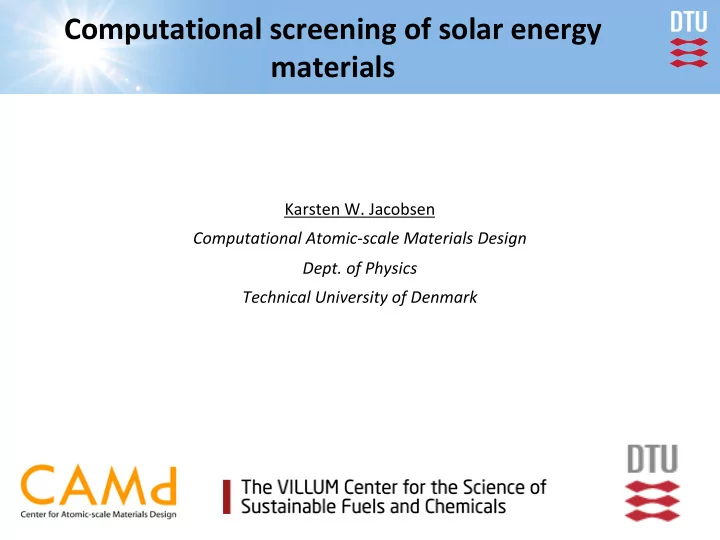

Computational screening of solar energy materials Karsten W. Jacobsen Computational Atomic-scale Materials Design Dept. of Physics Technical University of Denmark
Computational materials screening • What is the problem we want to solve? What are the properties of the “dream material”? • What do we compute – descriptors? • How do we search in the materials space?
Light induced water splitting Tandem cells Produce hydrogen as a fuel (and save the World) Light absorbing materials ‒ small/large band gaps Protection layers Catalysts p-n junctions The challenge: Small bandgap semiconductor: ~1.1 eV Silicon Large bandgap semiconductor: ~1.8 eV ?????
Searching for light absorbing materials • Mapping out a particular class of materials • Perovskites • Known materials • Inorganic crystal structure database (ICSD) • Searches guided by correlations in materials space • Machine learning
� � � � Sulfide perovskites Screening funnel Initial structures: (Experimental databases or hypothetical) Semiconducting Stability Band structure Discarded More Defect tolerance materials demanding Absorptivity calculations ... Candidates for experimental investigation
Identify semiconducting ABS 3 compounds 53 metal atoms 53 * 53 = 2809 compounds Test for bandgap > 0 in distorted 5 atom unit cell 129 compounds identified
Perovskite sulfides Screening funnel Most common ABS 3 structures in ICSD Y.-Y. Sun et al., Nano Lett 15 , 581 (2015) Kuhar, Crovetto, Pandey, Thygesen, Seger, Vesborg, Hansen, Chorkendorff, Jacobsen, Energy and Environmental Science, 10 , 2579 (2017).
Stability Band gap TeHfS 3 ZrMgS 3 Energy of formation Use mBEEF uncertainties on energy of Unstable relative to decomposition formation to improve predictions.
Band gaps (calculated with GLLB) Water splitting Photovoltaics Band gaps White circle: One structure significantly more stable Bold: All low-energy structures with interesting gaps Crosses: AB->BA
Mobility – effective masses Mobility µ ∝ 1 /m electron hole
Defect tolerance/sensitivity of ABS 3 compounds Electronic density-of-states Defect Defect sensitive tolerant No mid-gap states Mid-gap states introduced by vacancy introduced by vacancy
Interesting sulfides for photoabsorption (15 candidate materials) Bold: all low-energy phases have relevant band gaps BaZrS 3 : W. Meng et al., Chem Mater , 28 , 821 (2016) Kuhar, Crovetto, Pandey, Thygesen, Seger, Vesborg, Hansen, Chorkendorff, Jacobsen, Energy and Environmental Science, 10 , 2579 (2017).
LaYS 3 Synthesis and characterization Thin films produced by deposition of La and Y followed by sulfurization. XRD pattern: Match within .2° Experimental spectrum Match within .3° Theoretical spectrum for CeTmS 3 structure Theoretical spectrum calculated for random orientation. Blue curve with .2° smearing. Kuhar, Crovetto, Pandey, Thygesen, Seger, Vesborg, Hansen, Chorkendorff, Jacobsen, Energy and Environmental Science, 10 , 2579 (2017).
LaYS 3 Band gap Spectroscopic ellipsometry ‒ light absorption coefficient Direct band gap determined from absorption coefficient and refractive index Kuhar, Crovetto, Pandey, Thygesen, Seger, Vesborg, Hansen, Chorkendorff, Jacobsen, Energy and Environmental Science, 10 , 2579 (2017).
LaYS 3 Photoluminescence Strong photoluminescence signal Defects not giving rise to non-radiative processes. Performance in water-splitting device being investigated. (Andrea Crovetto).
Limitations • Limited compositions (ABS 3 ) • Limited number of structures (6) • Absorption: band gap with GLLB (±0.4 eV) • Mobility: effective mass • Defects: only neutral vacancies • But still useful: • 2809 -> 15 materials
Screening of known materials for photovoltaics or water splitting Advantages: Materials known to be stable or metastable Known synthesis procedures Kuhar, Pandey, Thygesen, Jacobsen, ACS Energy Letters, doi:10.1021.acsenergylett.7b01312 (2018).
Abundance and Herfindahl−Hirschman index Only abundant elements without a monopoly market.
Screening funnel Toxicity, abundance, HHI Binary or ternary Materials in ICSD and OQMD PBE band gap available in OQMD 0 < E g < 2 eV
Screening funnel (cont.) Band gap calculated with GLLB Water splitting Photovoltaics Kuhar, Pandey, Thygesen, Jacobsen, ACS Energy Letters, doi:10.1021.acsenergylett.7b01312 (2018).
Screening results (74 materials) Antiperovskite Known perovskites Some interesting candidates for water splitting: Hf 3 N 4 , NbI 5 , SrS 3 , Zr 3 N 4 Ba 3 SbN, BaZrN 2 , Cs 6 GaSb 3 , CsGeCl 3 , Rb 2 SnBr 6 , Sr 3 GaN 3 , and Sr 3 SbN Kuhar, Pandey, Thygesen, Jacobsen, ACS Energy Letters, doi:10.1021.acsenergylett.7b01312 (2018).
Machine learning new materials • Many different techniques • Representation of materials (fingerprints, … ) • Kernel regression, neural networks, … • Two challenges: • Can we predict material properties without knowing where the atoms are? • Can we avoid evaluation of properties of many (irrelevant) materials? Can we directly identify relevant materials?
Organic solar cell (PCBM-based blended polymer solar cell) PCBM = Phenyl-C’61-Butyric-Acid-Methyl-Ester
Donor-acceptor molecules (polymer units) What is the position of the LUMO and the optical gap for these molecules? In principle 10 14 molecules! Training set with ~4000 molecules (Gaussian, B3LYP) Jørgensen, Mesta, Shil, García Lastra, Jacobsen, Thygesen, and Schmidt, (2018).
Data representation String representation of molecules. Grammatical production rules. No specification of atomic coordinates. Earlier work uses SMILES to represent molecules: Gómez-Bombarelli et al. (2016), arXiv:1610.02415 [cs.LG]. Kusner et al. (2017), arXiv:1703.01925 [stat.ML].
Grammar Variational AutoEncoder 32-dimensional vector space (“latent” space) Strings (grammar) Jørgensen, Mesta, Shil, García Lastra, Jacobsen, Thygesen, and Schmidt, (2018).
Latent space First two principal components. Bright points are within target range for LUMO energy and optical band gap. New materials can be predicted by optimization or interpolation in the latent vector space. Decoder: Latent space -> strings -> molecules
Prediction of new molecules Target region 100 new molecules predicted Optical band gap LUMO energy
Computational screening and exa-scale: Some naïve considerations • Opportunities • Screening more different materials • More accurate calculations Light absorption, PBE -> GLLB – > GW -> BSE • • New properties Carrier lifetimes • • Challenges • Better and more descriptors 1% of 1000 materials -> 10 candidates • 1% of 10 6 materials -> 10000 candidates •
Acknowledgements CAMD/DTU: SURFCAT/DTU: Mohnish Pandey Andrea Crovetto Korina Kuhar Brian Seger Ivano E. Castelli Søren Dahl Suranjan Shil Peter Vesborg Thomas Olsen Ole Hansen Kristian S. Thygesen Ib Chorkendorff DTU ENERGY: Murat Mesta Juan Maria Garcia-Lastra DTU COMPUTE: Peter Bjørn Jørgensen Mikkel N. Schmidt CASE Catalysis for Sustainable Energy
Recommend
More recommend